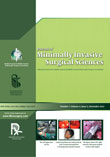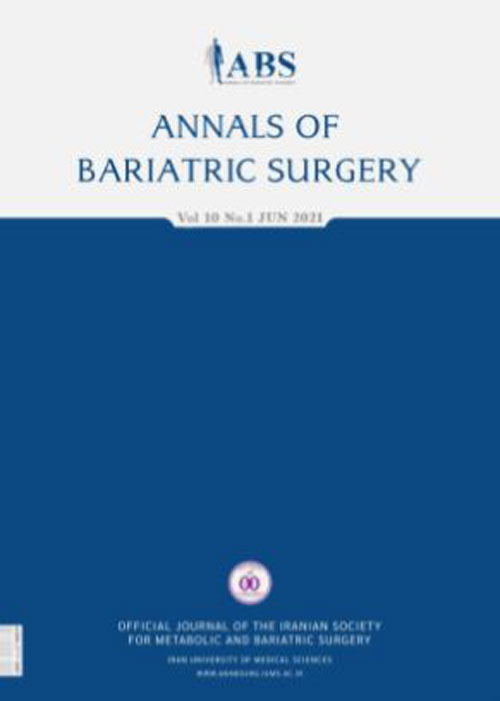فهرست مطالب

Annals of Bariatric Surgery
Volume:5 Issue: 3, Summer 2016
- تاریخ انتشار: 1395/07/12
- تعداد عناوین: 5
-
-
Page 1BackgroundProspective studies evaluating outcome of laparoscopic Heller myotomy and Dor fundoplication for esophageal achalasia are less in Asian people.ObjectivesThis study conducted to evaluate the results of laparoscopic cardiomyotomy and partial fundoplication for achalasia.
Patients andMethodsThirty patients who underwent Heller myotomy for achalasia via laparoscopy in Alzahra hospital Isfahan, Iran were recorded prospectively (2009 - 2013). Median follow-up was 18 months. Symptoms including dysphagia, regurgitation, chest pain and weight loss were recorded before and after operation. Also, previous treatment for achalasia such as endoscopic pneumatic dilatations and intrasphincteric injection of botulinum toxin or other component, duration of symptoms and duration and complication of operation was recorded.ResultsAmong 30 patients, there were 13 (43.3%) females and 17 (56.7%) males, and mean age was 40.8 years (range, 20 - 68 years). The operations were finished laparoscopically in all patients. Mean operative time was 137 ± 36.2 minutes. The patients were symptomatic for at least 30 months before referring for surgery. There are some difficulties in dissection in cases who received Ethanolamine or Botholinum Toxin injection as non-surgical treatment before that. Mean hospital stay was 2.45 days. Regurgitation, chest pain and heartburn relieved significantly in median follow up of 18 months, in 100%, 66.6% and 70%, respectively (PConclusionsOur study showed that laparascopic Helermyotomy with Dor fundoplication result in significant relief of dysphagia. Overall clinical symptoms indicate improvement in patient functional status during 18-month follow-up.Keywords: Esophageal Achalasia, Laparoscopic Myotomy, Dor Fundoplication, Dysphagia -
Page 2BackgroundObesity is one of the important chronic diseases with high growth in worldwide and bariatric surgery is currently considered the most effective treatment for weight reduction.ObjectivesWe aimed to analyze weight loss follow up and diabetes management in patients submitted to mini gastric bypass on use of vitamin and mineral supplementation, in the new set up center, in Mazandaran province for the first time.MethodsProspective analysis of 27 volunteers of both sexes, aged between 23 - 52 years, using laparoscopic mini gastric bypass in Saris Avicenna hospital, were included; personal information, anthropometric and laboratory data in the preoperative, 3, 6 and 9 months were collected. Statistical analysis was done with SPSS, 19 and using the Wilcoxon and Friedman test.ResultsDuring follow up time after 276 days mean weight decreased from 118.7 ± 23.3 to 82.9 ± 15.7, PConclusionsIn the newly set up center similar to the older one, surgical treatment in our follow up duration was effective for reducing weight, body mass index reduction and achievement of success in biochemical markers on diabetics.Keywords: Obesity, Weight Loss, BMI, Mini Gastric Bypass, Diabetics
-
Page 3BackgroundLaparoscopic appendicectomy is safe and feasible for non-complicated appendicitis. The use of retrograde appendicectomy allows feasibility also for complicated cases. Using single polymer clip for securing appendicular stump is safe as well as two clips.ObjectivesTo evaluate the clinical outcome of using single Hem-O-Lock polymer clip and to compare technical feasibility of retrograde laparoscopic appendicectomy for complicated versus non-complicated appendicitis in adults.
Patients andMethodsA single institute prospective study was done between August 2012 and April 2014. From 78 patients presenting with acute appendicitis to emergency unit, Zagazig University hospitals, only 60 patients were eligible. Three retrograde laparoscopic appendicectomy ports were used in both groups (group I, complicated appendicitis and group II, non-complicated appendicitis) and a single Hem-O-Lock polymer clip was applied to secure the appendicular stump. Standardized data collection was performed and data collected by the attending resident and attending physician. The primary clinical outcome was the severity of pain at 1 - 7 days. Secondary outcomes included the duration of operation (minutes), procedure-related complications, conversion rates, and length of hospital stay.ResultsFour patients (15.4%) were converted to open surgery; three patients in group I and one in group II. Four patients developed postoperative complications; three patients in group I and one in group II. Operative time was less in group II and was statistically different and the P value was significant 0.05.ConclusionsRetrograde laparoscopic appendicectomy using single polymer clip makes easy access to operating in complicated and non-complicated appendicitis.Keywords: Complicated Appendicitis, Polymer Clips, Laparoscopic Appendicectomy -
Page 4IntroductionIleal diverticulum is a rare disease that presents with complications such as diverticulitis.Case PresentationWe present an 81-year-old man with partial small bowel obstruction having abdominal pain, nausea, vomiting for 48 hours and a mobile abdominal mass. After CT scan, exploratory laparoscopy and small bowel resection was done with primary anastomosis.ConclusionsWhen adhesion, internal hernia and malignancy are ruled out in patient presenting with partial obstruction and abdominal mass, other causes like diverticula must be considered.Keywords: Diverticulitis, Ileum, Intestinal Obstruction, Laparoscopy
-
Page 5BackgroundThe feasibility of safe full laparoscopic Cephalic duodenopancreatectomy (CDP) has been demonstrated by several authors.ObjectivesFor its realization, we propose a 5 trocars approach.MethodsKocher maneuver is performed to reach the inferior vena cava, the infrarenal aorta, the rear plate of the uncinate process, and the superior mesenteric artery. Lymphadenectomy in the region can be done in a comprehensive way; interaortico cave, around the hepatico-duodenal ligament, and the celiac trunk and its branches. After dissection of the portal vein (PV), the pancreas can be cut away from the tumor, and its right part is separated from the PV. The duodenal bulb and the first jejunal loop are cut using a linear stapler. After cholecystectomy, the bile duct is cut upstream of the cystic.ResultsThe reconstruction will include three anastomoses: termino-lateral posterior pancreatogastric by telescoping, end-to-side duodeno-jejunal and end-to-side hepatico-jejunal anastomoses.ConclusionsThe Cephalic duodenopancreatectomy (CDP) is entirely feasible laparoscopically. In obese patients, the CPD is more simple by laparoscopy. Of course, performing this complex procedure requires a careful selection of patients and an experienced surgical team.Keywords: Laparoscopic, Pancreaticoduodenectomy, Technic's Description


